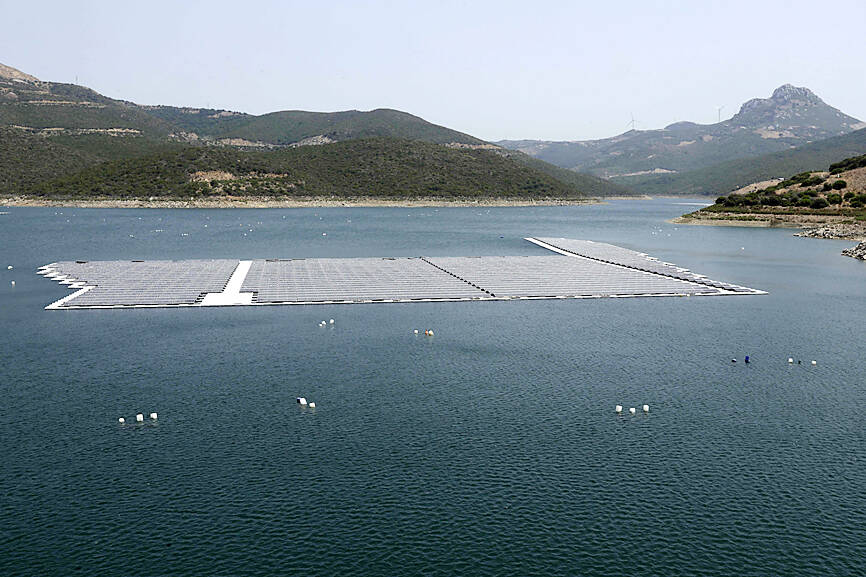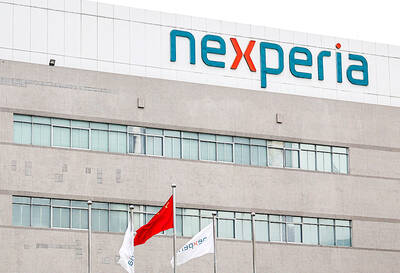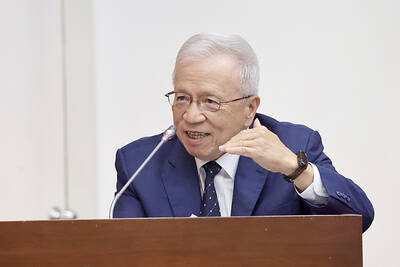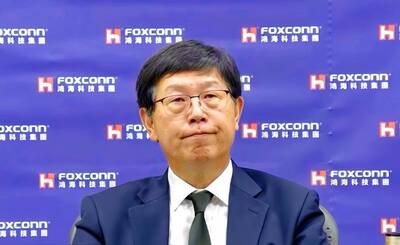Sun-baked Morocco, grappling with its worst drought in decades, has launched a pilot project aimed at slowing water evaporation while simultaneously generating green energy using floating solar panels.
At a major reservoir near the northern city of Tangier, thousands of so-called “floatovoltaic” panels protect the water’s surface from the blazing sun and absorb its light to generate electricity.
Authorities plan to power the neighboring Tanger Med port complex with the resulting energy, and if it proves a success, the technology could have far wider implications for the North African kingdom.

Photo: AFP
Morocco’s water reserves lost the equivalent of more than 600 Olympic-sized swimming pools every day to evaporation between October 2022 and September 2023, according to government data.
Over that same period, temperatures averaged 1.8°C higher than normal, meaning water evaporated at a higher rate.
Alongside other factors such as declining rainfall, this has reduced reservoirs nationwide to about one-third of their capacity.
Moroccan Ministry of Equipment, Transport, Logistics and Water official Yassine Wahbi said the Tangier reservoir loses about 3,000 cubic meters a day to evaporation, but that figure more than doubles in the hot summer months.
The floating photovoltaic panels can help cut evaporation by about 30 percent, he said.
The water ministry said the floating panels represent “an important gain in a context of increasingly scarce water resources,” even if the evaporation they stop is, for now, relatively marginal.
Assessment studies are underway for another two similar projects in Oued El Makhazine, at one of Morocco’s largest dams in the north, and in Lalla Takerkoust near Marrakesh.
Similar technology is being tested in France, Indonesia and Thailand, while China already operates some of the world’s largest floating solar farms.
Since the Moroccan pilot program began late last year, more than 400 floating platforms supporting several thousand panels have been installed.
The government wants more, planning to reach 22,000 panels that would cover about 10 hectares at the 123-hectare Tangier reservoir.
Once completed, the system would generate about 13 megawatts of electricity — enough to power the Tanger Med complex — a vast industrial port hub on Morocco’s Mediterranean coast.
Authorities also have plans to plant trees along the banks of the reservoir to reduce winds, which are believed to exacerbate evaporation.
Hassan II University of Casablanca professor of climatology Mohammed-Said Karrouk called it a “pioneering” project.
However, the reservoir is too large and its surface too irregular to be covered completely with floating panels, which could be damaged with fluctuating water levels, he said.
Water reserves fed by rainfall have fallen by nearly 75 percent in the past decade compared with the 1980s, dropping from an annual average of 18 billion cubic meters to only five, official data showed.
Morocco has so far mainly relied on desalination to combat shortages, producing about 320 million cubic meters of potable water a year.
Authorities aim to expand production to 1.7 billion cubic meters yearly by 2030.
Karrouk said an urgent priority should be transferring surplus water from northern dams to regions in central and southern Morocco that are more impacted by the years-long drought.
The kingdom already has a system dubbed the “water highway” — a 67km canal linking the Sebou basin to the capital, Rabat — with plans to expand the network to other dams.

JITTERS: Nexperia has a 20 percent market share for chips powering simpler features such as window controls, and changing supply chains could take years European carmakers are looking into ways to scratch components made with parts from China, spooked by deepening geopolitical spats playing out through chipmaker Nexperia BV and Beijing’s export controls on rare earths. To protect operations from trade ructions, several automakers are pushing major suppliers to find permanent alternatives to Chinese semiconductors, people familiar with the matter said. The industry is considering broader changes to its supply chain to adapt to shifting geopolitics, Europe’s main suppliers lobby CLEPA head Matthias Zink said. “We had some indications already — questions like: ‘How can you supply me without this dependency on China?’” Zink, who also

At least US$50 million for the freedom of an Emirati sheikh: That is the king’s ransom paid two weeks ago to militants linked to al-Qaeda who are pushing to topple the Malian government and impose Islamic law. Alongside a crippling fuel blockade, the Group for the Support of Islam and Muslims (JNIM) has made kidnapping wealthy foreigners for a ransom a pillar of its strategy of “economic jihad.” Its goal: Oust the junta, which has struggled to contain Mali’s decade-long insurgency since taking power following back-to-back coups in 2020 and 2021, by scaring away investors and paralyzing the west African country’s economy.

BUST FEARS: While a KMT legislator asked if an AI bubble could affect Taiwan, the DGBAS minister said the sector appears on track to continue growing The local property market has cooled down moderately following a series of credit control measures designed to contain speculation, the central bank said yesterday, while remaining tight-lipped about potential rule relaxations. Lawmakers in a meeting of the legislature’s Finance Committee voiced concerns to central bank officials that the credit control measures have adversely affected the government’s tax income and small and medium-sized property developers, with limited positive effects. Housing prices have been climbing since 2016, even when the central bank imposed its first set of control measures in 2020, Chinese Nationalist Party (KMT) Legislator Lo Ting-wei (羅廷瑋) said. “Since the second half of

AI BOOST: Next year, the cloud and networking product business is expected to remain a key revenue pillar for the company, Hon Hai chairman Young Liu said Manufacturing giant Hon Hai Precision Industry Co (鴻海精密) yesterday posted its best third-quarter profit in the company’s history, backed by strong demand for artificial intelligence (AI) servers. Net profit expanded 17 percent annually to NT$57.67 billion (US$1.86 billion) from NT$44.36 billion, the company said. On a quarterly basis, net profit soared 30 percent from NT$44.36 billion, it said. Hon Hai, which is Apple Inc’s primary iPhone assembler and makes servers powered by Nvidia Corp’s AI accelerators, said earnings per share expanded to NT$4.15 from NT$3.55 a year earlier and NT$3.19 in the second quarter. Gross margin improved to 6.35 percent,